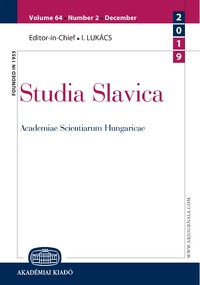Функціювання лексики на позначення стихійних явищ в українській мові XVІ–XVIII ст.
The Functioning of the Vocabulary Designating Natural Disasters in the Ukrainian Language in the 16th–18th Centuries
Author(s): Vasyl DenysiukSubject(s): Eastern Slavic Languages
Published by: Akadémiai Kiadó
Keywords: the Ukrainian language; 16th–18th centuries; vocabulary; lexeme; semantics; semantic structure; metaphorical transfer; natural disasters
Summary/Abstract: The study of the peculiarities of the functioning of the vocabulary designating natural disasters performed on the basis of written monuments of the Ukrainian language in the 16th–18th centuries allows us to state that the genetically analyzed lexemes in this thematic group are of Proto-Slavic origin. The only exception is the borrowing пожога from the Polish language. The vocabulary designating natural disasters was actively completed due to the inclusion of lexical units from other thematic groups including meteorological vocabulary and the development of new meanings in these words because of semantic shifts representing the general concept of ‘natural disasters’ during the declared period. The analyzed lexemes demonstrate one type of systemic relations: synonymous. One-word names show activity according to the structure of the analyzed written texts. The contextual environment helps to find out the corresponding semantics of them. The authors often use multi-word names which include a noun and an adjective (they are usually the adjectives великий, лютий or forms of the highest degree of comparison превеликіе, прежестокій, which explicitly indicate a high degree of the described disaster). It is noteworthy that the authors use the verbal noun потоп for the realization of the seme ‘flood’, which gradually started to lose its religious semantics and acquired a secular meaning in the period under study. The Kievan Rus’ tradition is continued by the nomination of this disaster by a verb–noun or an adjective– noun word combination. The main representative of the seme ‘drought’ is the adjective сухий, which is used exclusively in the descriptive constructions in the studied monuments, the substantive component of which is a lexeme to denote a season (весна, літо, осінь). The lexemes холод and мороз realize the seme ‘cold’ in the analyzed written texts. They are used in their full-vowel forms and combined with quantitative forms of adjectives to represent the degree of the natural disaster. A subjective approach to the assessment of the disaster is observed in the implementation of this seme. The lexeme сніг in many contexts implements syncretized semantics: ‘precipitation’ and ‘natural disaster’. A clear idea of the natural disaster is given by the contexts in which the authors use the additional qualifier великій. Occasionally, the adverb with the value of amount combined with another adverb with the value of extent and degree performs the role of an additional qualifier. As evidenced by modern lexicographic works, the development of a figurative meaning occurred in the semantic structure of nouns on the basis of metaphorical transfer. The present-day Ukrainian language inherited most of the one-word names, which continue to operate without changing their basic lexical meaning.
Journal: Studia Slavica Academiae Scientiarum Hungaricae
- Issue Year: 65/2020
- Issue No: 2
- Page Range: 237-248
- Page Count: 12
- Language: Ukrainian
- Content File-PDF

